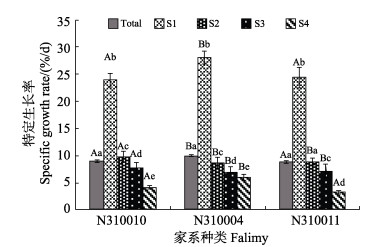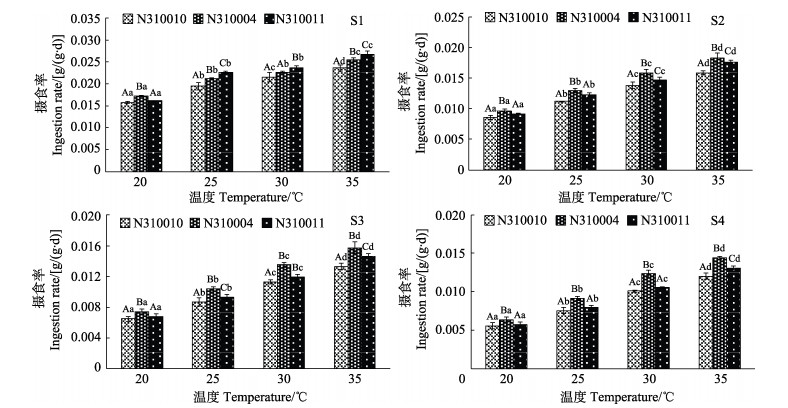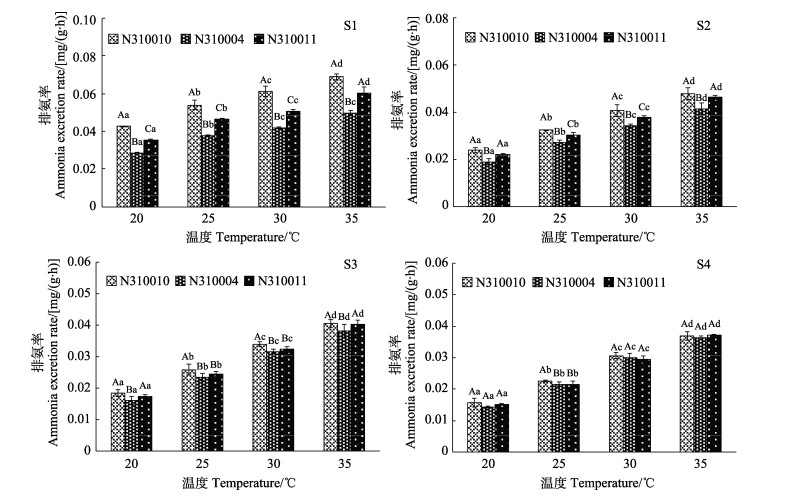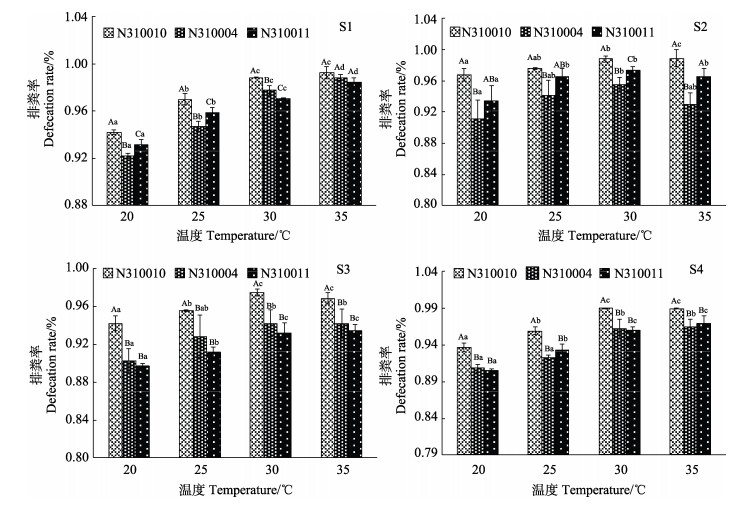2. 青岛海洋科学与技术试点国家实验室海洋渔业科学与食物产出过程功能实验室中国水产科学研究院黄海水产研究所 农业农村部海洋渔业可持续发展重点实验室 山东 青岛 266071
2. Laboratory for Marine Fisheries Science and Food Production Processes, Pilot National Laboratory for Marine Science and Technology (Qingdao); Yellow Sea Fisheries Research Institute, Chinese Academy of Fishery Sciences; Key Laboratory of Sustainable Development of Marine Fisheries, Ministry of Agriculture and Rural Affairs, Qingdao 266071, China
凡纳滨对虾(Litopenaeus vannamei)具有生长快、抗逆力强、适合高密度养殖等特点,是对虾养殖的主要品种(樊云鹏等, 2021)。2020年我国凡纳滨对虾海水养殖产量达119.7万t,位居养殖甲壳类首位,为渔民创收及水产品出口创汇做出重要贡献(农业农村部渔业渔政管理局等, 2021)。水温是影响对虾生长、发育及代谢强度的重要环境因子之一。对虾为变温动物,其体温随着环境温度的变化而变化,而不同环境温度会影响机体的新陈代谢和生理调节机制(徐德峰等, 2019)。
选择育种是提高水产动物经济效益的重要手段,通过建立家系并进行分析和比较,能更好地改善凡纳滨对虾的遗传性状(罗坤等, 2018)。近年来,凡纳滨对虾的选育研究工作主要聚焦于生长、抗病性和抗逆性三大性状。其中,生长速度快的良种将有助于提高养殖产量、降低养殖成本,为养殖企业带来更高的经济效益。而凡纳滨对虾的摄食、代谢及能量收支是反映其生长特性的重要指标。另外,水温是影响生物生理活动的关键因子,同时也对重要经济水产动物(如凡纳滨对虾等)的能量收支产生重要影响(Zanna et al, 2019; Jescovitch et al, 2017; 唐扬等, 2018)。因此,深入了解温度等理化环境因子对不同家系的凡纳滨对虾生长发育及能量收支的影响,从生理生态学角度助力凡纳滨对虾选育研发,厘清不同温度条件下凡纳滨对虾的能量分配模式,对凡纳滨对虾的选育工作具有重要意义。目前,关于不同家系的凡纳滨对虾生长的能量学基础及其温度的影响未见报道。因此,本研究通过建立不同家系的能量分配模型,了解温度对凡纳滨对虾能量收支和分配的影响,从生物能量学角度,为凡纳滨对虾的健康养殖和良种选育提供理论和数据支撑。
1 材料与方法 1.1 实验材料实验所用凡纳滨对虾取自山东邦普种业科技有限公司。从“快大系”中挑选出的生长快(N310004)、中(N310011)、慢(N310010) 3个家系,其体长分别为(1.56±0.22)、(1.57±0.23)和(1.62±0.27) cm,其体重分别为(0.18±0.04)、(0.16±0.07)和(0.15±0.03) g。
1.2 实验方法 1.2.1 凡纳滨对虾的生长实验3个家系分别放入圆筒缸(直径为150 cm,高为200 cm),每个家系200尾。养殖温度为(30±1) ℃,盐度为30。每天06:00、12:00和18:00投喂对虾配合饲料,18:30换水(换水量为1/3)。养殖时间为40 d,每10 d分别取出20尾测定体长、湿重和干重。
1.2.2 凡纳滨对虾不同家系能量收支测定温度设置及控制:实验温度设置为20、25、30、35 ℃ 4个水平,每个温度设置3个平行实验组和2个空白实验组,每个实验组放置1尾虾。采用加热棒调控水温,每天调控温度控制在2 ℃(宋协法等, 2009),在每个温度条件下适应3 d后开始实验。从第0天开始,第40天结束,每10 d测定一次能量收支,分别用S1 (0~10 d)、S2 (11~20 d)、S3 (21~30 d)和S4 (31~40 d)表示。
摄食率和排粪率的测定:每个整理箱放入1尾虾,饲料投喂量为体重的5%,摄食时间为4 h。实验后,用虹吸法收集残铒和粪便。60 ℃烘干实验前的饲料和实验后的残铒,称重,得出实际摄食饲料重,将吸取的粪便过滤到玻璃纤维滤膜(GF/F)上,烘干至恒重,测定实际粪便重。
耗氧率和排氨率的测定:耗氧率的测定方法参考朱玉杰等(2012),具体如下:实验在1 L锥形瓶中进行,每个瓶中放1尾虾。实验采用静水法,水浴控温,并用封口膜封口,实验进行2 h后测定呼吸瓶中的溶解氧和氨氮含量,实验结束时溶解氧高于4 mg/L,并称取对虾湿体重。使用便携式溶氧仪YSI测定实验前后的溶解氧。实验前后取250 mL水,使用0.45 μm滤膜过滤,用于氨氮的测定(QuAAtro全自动营养盐分析仪, 德国SEAL公司)。
1.3 能量收支方程及相关计算公式实验期间凡纳滨对虾特定生长率、摄食率、耗氧率、排氨率分别按以下公式计算:
| $\begin{array}{c} \text { 特定生长率 }(\mathrm{SGR}, \% / \mathrm{d})=100 \% \times\left(\ln W_2-\ln W_1\right) / t\\ \text { 摄食率 }[\mathrm{FR}, \mathrm{g} /(\mathrm{g} \cdot \mathrm{h})]=\left(F_1-F_2\right) /\left(W_d \times t_1\right)\\ \text { 耗氧率 }[\mathrm{OR}, \mathrm{mg} /(\mathrm{g} \cdot \mathrm{h})]=\left[\left(\mathrm{DO}_0-\mathrm{DO}_{\mathrm{t}}\right) \times V\right] /\left(W_d \times t_1\right)\\ \text { 排氨率 }[\mathrm{NR}, \mathrm{mg} /(\mathrm{g} \cdot \mathrm{h})]=\left[\left(N_t-N_0\right) \times V\right] /\left(W_d \times t_1\right)\end{array} $ |
式中,W1为初始平均湿重(g),W2为终末平均湿重(g),t为实验天数(d),F1为投喂量(g),F2为残饵量(g),Wd为个体干重(g),t1为时间(h),DO0为空白组溶解氧含量(mg/L),DOt为实验组溶解氧含量(mg/L),V为实验用水的体积(L),N0为空白组氨氮浓度(mg/L),Nt为实验组氨氮浓度(mg/L)。
凡纳滨对虾能量收支方程为:
| $ C=P+R+U+F $ |
式中,C为摄食能,P为生长能,R为代谢能,U为排泄能,F为粪便能,单位均为J/(g·d)。
参照朱长波等(2010)计算各项能量:
摄食能C=FR×20.78×1000;
粪便能F=粪便干重×20.78×1000
代谢能R=OR×14.24;
排泄能U=NR×24.87;
生长能P=C–R–U–F
式中,摄食能及粪便能转化系数为20.78 J/mg,代谢能转化系数为14.24 J/mg O2,排泄能转化系数为24.87 J/mg N。
1.4 数据处理采用SPSS 19.0对数据进行统计学分析,采用单因素方差分析(one-way ANOVA)进行显著性分析,采用Duncan法进行组间、组内多重比较。P < 0.05为差异显著,P < 0.01代表差异极显著。
2 结果 2.1 凡纳滨对虾的特定生长率(SGR)3个家系总SGR及各个阶段(S1、S2、S3和S4) SGR见图 1。N310004家系生长最快,总SGR达(9.79± 0.22)%,显著高于其他家系(P < 0.05)。除S2和S3阶段外(N310004家系SGR与N310011家系无显著性差异),其他阶段N310004家系的SGR都显著高于其他2个家系(P < 0.05)。

|
图 1 凡纳滨对虾不同家系在不同阶段的特定生长率 Fig.1 Specific growth rate of different families L. vannamei at different stages 大写字母表示同一阶段不同家系差异显著(P < 0.05),小写字母表示相同家系不同阶段差异显著(P < 0.05)。 Uppercase letters represent significant difference between different families at the same stage, while lowercase letters represent significant difference between the same family at different stages (P < 0.05). |
能量收支实验中3个家系的凡纳滨对虾生物学指标见表 1,在S2、S3和S4时期,N310004家系的体长、体重和干重3个生物学数据均显著高于家系N310010和N310011。
|
|
表 1 不同阶段下各家系生物学指标 Tab.1 Biological indexes of L. vannamei families at different stages |
温度对不同家系凡纳滨对虾FR的影响见图 2。从图 2可以看出,随着温度的升高,3个家系在同一时期的FR显著升高,均在35℃时达到最大值。在不同时期,3个家系的FR差异显著(P < 0.05)。S1时期在20 ℃时,N310004家系的FR显著高于其他2个家系;在25~35 ℃时,N310011家系的FR显著高于其他家系。在S2、S3和S4时期,N310004家系的FR均显著高于其他2个家系。

|
图 2 温度对不同家系凡纳滨对虾摄食率的影响 Fig.2 Effect of temperature on feeding rate of different L. vannamei families 不同小写字母表示相同家系不同温度下差异显著(P < 0.05);不同大写字母表示相同温度下不同家系差异显著(P < 0.05)。下同。 Different lowercase letters indicate significant differences at different temperatures in the same family (P < 0.05);Different uppercase letters indicate significant differences of different families at the same temperature (P < 0.05). The same as below. |
温度对不同家系凡纳滨对虾OR的影响见图 3。温度对于不同家系凡纳滨对虾的OR有显著影响(P < 0.05)。总体来讲,在实验温度范围内,随着温度升高,凡纳滨对虾的OR显著升高。不同家系在不同时期的OR也有显著性差异。S1时期在25~35 ℃时,N310011家系的OR显著高于其他2个家系;S2时期在35 ℃时,N310011家系的OR显著高于其他2个家系,其他2个家系无显著差异,S3时期在30~35 ℃时,N310010家系显著高于其他2个家系,S4时期N310010家系显著高于其他2个家系。

|
图 3 温度对不同家系凡纳滨对虾耗氧率的影响 Fig.3 Effect of temperature on oxygen consumption rate of different L. vannamei families |
温度对不同家系的凡纳滨对虾NR的影响见图 4,实验中对虾的NR在0.014~0.068 mg/(g·h)之间。方差分析结果显示,在同一时期,NR随着温度的升高显著升高。在不同时期,随着体重的增大,NR显著降低(P < 0.05)。在S1~S2时期,N310004家系在各个温度条件下的NR显著低于其他2个家系;在S3时期25~30 ℃时,N310010家系的NR显著高于其他家系;在S4时期温度为20、30、35 ℃时,3个家系无显著差异,25 ℃时,N310010家系显著高于其他家系。

|
图 4 温度对不同家系凡纳滨对虾排氨率的影响 Fig.4 Effect of temperature on ammonia excretion rate of different L. vannamei families |
温度对不同家系的凡纳滨对虾排粪率的影响见图 5。如图 5所示,在实验温度范围内,在S1时期,3个家系排粪率随着温度的升高而显著升高,其他时期3个家系在20~30 ℃时,排粪率随着温度的升高而显著升高,温度达到35 ℃时,与30 ℃时排粪率无显著差异。当规格不同时,排粪率也有显著差异。在S1时期20~30℃时,N310010家系排粪率显著高于其他家系;在S2时期,N310004家系排粪率显著低于其他2个家系,在S3~S4时期,N310010家系在各个温度下排粪率显著高于其他家系。

|
图 5 温度对不同家系凡纳滨对虾排粪率的影响 Fig.5 Effect of temperature on defecation rate of different L. vannamei families |
不同温度条件下各家系能量收支见表 2。表 2中各家系能量收支为4个时期各能量总和。3个家系的摄食能、代谢能和排泄能都随着温度的升高逐渐升高,而生长能先升高后降低,在30℃时出现峰值。N310004家系摄食能在4个温度条件下均显著高于其他2个家系,代谢能和排泄能显著低于其他2个家系,而粪便能较高,生长能显著高于其他2个家系。
|
|
表 2 不同温度下凡纳滨对虾各家系的能量收支情况 Tab.2 Energy budget of different L. vannamei families at different temperatures |
不同家系凡纳滨对虾能量收支方程随温度的变化情况见表 3。表 3中各家系占摄食能的比例为4个时期的总和。整体来讲,呼吸消耗的能量占比最大,达77.81%。其次是生长能,粪便能的占比最小。N310004家系的生长能占比为19.69%~22.24% (平均值为20.80%)。其他2个家系的生长能占比仅为15.61%和12.25%。
|
|
表 3 不同温度下凡纳滨对虾各家系的能量收支方程(占摄食能的百分比) Tab.3 Energy budget equation of different families at different temperatures (percentage of energy intake) |
温度是影响海洋生物生存发育和生理响应策略的重要因素(刘毅等, 2020)。温度的变化会影响对虾摄食,进而导致对虾代谢及生长差异(肖善势等, 2016)。在适温范围(25~30 ℃)内,随着温度的升高,凡纳滨对虾可调节其生理响应来提高摄食率(Estrada-Cárdenas et al, 2021)。本研究表明,不同家系的摄食率、耗氧率、排氨率等生理生态学指标随温度变化呈现出较大差异。其中,N310004家系摄食率显著高于其他家系,说明其从饵料中获得的能量更高,从而导致其特定生长率更高。另外,当温度为20 ℃时,凡纳滨对虾的摄食与生长水平会下降(Bórquez-Lopez et al, 2018),虽然该温度在凡纳滨对虾适宜生长温度范围内,但由于凡纳滨对虾属于热带虾类,所以对高温变化的适应能力明显大于对低温变化的适应能力(张特等, 2012)。本研究表明,在20 ℃时,3个家系的摄食水平虽有显著差异,但摄食率都较低,说明凡纳滨对虾在温度较低时,通过减弱生理活动,将摄入的能量及体内能量主要用于适应环境的生理响应策略中。
在适宜温度条件下,水生动物耗氧率和排氨率随温度的升高而升高(王冲等, 2018; 刘洋等, 2022),锦绣龙虾(Panulirus ornatus)与红螯螯虾(Cherax quadricarinatus)等虾类均符合这一规律(罗嘉俊等, 2020; 周建聪等, 2022)。本研究结果显示,在实验温度(20~35 ℃)范围内,凡纳滨对虾的耗氧率、排氨率随温度的升高显著升高。在3个家系中,N310010家系在实验温度下,耗氧率及排氨率均显著高于其他2个家系,表明此家系将饵料中获取的能量更多地用于呼吸代谢;N310004家系耗氧率与排氨率最低,表明此家系摄入的能量占呼吸代谢的比例较小。所以,相同温度条件下不同家系代谢策略的不同,可能是导致其生长差异的原因之一。甲壳动物对温度的变化有一定的耐受范围,如克氏原螯虾(Procambarus clarkii)对温度有较强的耐受性,在其适温范围内,生长率随着温度的升高而显著升高,超出适宜温度会导致生长缓慢甚至死亡(张龙岗等, 2015)。本研究也表明,凡纳滨对虾在最适温度范围内生长能显著升高,当温度超过最适温度,达到35 ℃时,凡纳滨对虾的生长能显著低于30 ℃时,这主要是由于呼吸代谢的耗能增大而用于生长的能量减少所致。综上所述,凡纳滨对虾在最适温度范围内,随着温度升高生长能增高,主要归因于摄食率及摄入能量的升高幅度高于呼吸代谢消耗能量的增加幅度。
胡利华等(2021)为了测定在相同条件下的30个家系的适应能力,从中挑选了4个家系(适应力最强和最弱各2个)并测定了它们的耗氧率及排氨率,结果表明,适应力强的2个家系在不适条件下耗氧率、排氨率和特定生长率均显著高于其他家系。本研究从选育(快速生长性状)家系中选择了生长速度不同的3个家系研究其能量收支情况,N310004家系的特定生长率较高,主要是由于摄食能显著高于其他家系,并且代谢能及排泄能显著降低,从而使用于生长的能量比例增加。同时,当超出凡纳滨对虾最适温度范围时,N310004家系的摄食率也显著高于其他家系,耗氧率及排氨率显著低于其他家系,进而表明其适应能力更强于其他2个家系。因此,通过探究不同温度条件下不同家系的生长特性,有助于了解不同家系的生长优势的生理生态学基础,为速生良种的选育提供数据支撑。
3.2 不同家系凡纳滨对虾的能量收支对虾从饲料中获取能量来维持正常生长及生理活动,并且能量流动充斥着对虾整个生命活动中,能量学的核心内容是为了研究对虾体内能量收支关系和环境因子对能量收支的影响(Xue et al, 2021),对虾类的能量收支主要受生物因素(规格、生理状况和发育阶段等)和非生物因素(温度、盐度、pH等)影响(王吉桥等, 2004)。通过研究温度对对虾体内能量分配的影响,可以进一步调控养殖环境,以期使能量分配合理化,提高生长速率,提升养殖效率(吕慧明等, 2009; 王亚利等, 2021)。从能量收支方程C=P+R+U+F中可得出,对虾生长能主要由摄食能、排泄能、代谢能和粪便能共同决定。根据对虾能量收支特点,代谢能占摄食能的比例较大,通常范围在55%~80%之间(曾庆婷等, 2016);生长能通常在10%~29%之间(王兴强等, 2006);排泄能占比不大,通常在5%~10%之间(Augusto et al, 2020; Nandy et al, 2021);粪便能与排泄能占比相似,通常在3%~12%之间(Kasamechotchung et al, 2021; Al-Maliky et al, 2019)。本研究结果与以上结果相一致,不同家系的代谢能范围为64.89%~77.81%,占摄食能的比例最大,即呼吸代谢是影响对虾能量分配的主要因素。而生长能范围为10.68%~22.24%,仅次于代谢能。在适宜温度范围内,凡纳滨对虾生长能随着温度的升高而升高,超出适宜生长范围时,生长能下降,主要因为温度过高呼吸代谢耗能增加,其次是过高的水温影响了对虾的正常生理机能,导致其正常生长受到抑制。凡纳滨对虾在生长发育阶段需要耗能进行蜕壳生长,而蜕壳能仅占摄食能的0.2%~0.6% (田相利等, 2005),因蜕壳能所占比例较小,本研究中在计算中将蜕壳能并入生长能。
因此,不同规格、不同环境条件下的生理生化响应会直接影响对虾的能量收支特征,樊云鹏等(2021)研究表明,不同品系的凡纳滨对虾的产卵量、体重均存在显著差异。本研究中,即使同属快速生长品系中的3个不同家系的凡纳滨对虾,在相同的养殖环境中,特定生长率也有显著差异。N310004的特定生长率显著高于本研究中的其他2个家系。从能量收支的结果来看,N310004通过摄入更多的饵料,来保证自身的摄食能,同时为生长代谢提供更多的能量基础(任黎华等, 2011)。N310004家系将能量用于生长的比例比其他2个家系高5%~8%,该差异可能是决定3种家系生长速率快慢不同的原因。研究表明,海洋生物的生长状况和体内储备能量会随着其能量收支策略的变化而产生较大改变,并且当温度不同时,海洋生物也要调整能量支出来适应环境变化(钱秀娟等, 2021; Thomas et al, 2018)。因此,分析养殖生物的能量收支策略被认为是了解水生生物长期适应潜力的一个很好的指标(Nandy et al, 2021)。同时,在选育工作中,了解不同家系、品系的能量收支策略也是评估和选择快速生长家系和品系的重要依据。
4 结论本研究证实,温度对不同家系凡纳滨对虾摄食、代谢和能量收支存在显著影响;在实验温度范围内,随着温度的升高,凡纳滨对虾的摄食率、耗氧率、排氨率显著上升;生长能在30 ℃达到最大值,随后逐渐下降。N310004家系的特定生长速率最大,其生长能显著高于其他家系,主要原因是该家系有较高的摄食能和较低的代谢能。
AL-MALIKY T H Y, AL-NOOR S S, ALI M H. Effect of different temperatures on food consumption of juveniles shrimp Metapenaeus affinis (H. Milne Edwards, 1837). Arthropods, 2019, 8(1): 32-37 |
AUGUSTO A, NEW M B, SANTOS M R, et al. Energy budget and physiology in early ontogenetic stages of the Amazon River prawn. Aquaculture Reports, 2020, 18: 100446 DOI:10.1016/j.aqrep.2020.100446 |
BÓRQUEZ-LOPEZ R A, CASILLAS-HERNANDEZ R, LOPEZ-ELIAS J A, et al. Improving feeding strategies for shrimp farming using fuzzy logic, based on water quality parameters. Aquacultural Engineering, 2018, 81: 38-45 DOI:10.1016/j.aquaeng.2018.01.002 |
Bureau of Fisheries, Ministry of Agriculture and Rural Affairs, National Fisheries Technology Extension Center, China Society of Fisheries. China fishery statistical yearbook 2021. Beijing: China Agriculture Press, 2021 [农业农村部渔业渔政管理局, 全国水产技术推广总站, 中国水产学会. 2021中国渔业统计年鉴. 北京: 中国农业出版社, 2021]
|
ESTRADA-CÁRDENAS P, CRUZ-MORENO D G, RUIZ-RUIZ R, et al. Combined hypoxia and high temperature affect differentially the response of antioxidant enzymes, glutathione and hydrogen peroxide in the white shrimp Litopenaeus vannamei. Comparative Biochemistry and Physiology. Part A, Molecular and Integrative Physiology, 2021, 254: 110909 DOI:10.1016/j.cbpa.2021.110909 |
FAN Y P, TAN J, LUAN S, et al. Comparative analysis of breeding characteristics of different strains of Litopenaeus vannamei. Journal of Fishery Sciences of China, 2021, 28(9): 1141-1151 [樊云鹏, 谭健, 栾生, 等. 凡纳滨对虾不同品系繁育性状的比较分析. 中国水产科学, 2021, 28(9): 1141-1151] |
HU L H, SHI W, LIU G X, et al. Mechanisms of salinity adaptability of Litopenaeus vannamei under different salinity conditions. Acta Hydrobiologica Sinica, 2021, 45(2): 275-283 [胡利华, 施巍, 刘广绪, 等. 不同家系凡纳滨对虾对低盐度的适应能力及其适应机理. 水生生物学报, 2021, 45(2): 275-283] |
JESCOVITCH L N, BOYD C E, WHITIS G N. Effects of mechanical aeration in the waste-treatment cells of split-pond aquaculture systems on water quality. Aquaculture, 2017, 480: 32-41 DOI:10.1016/j.aquaculture.2017.08.001 |
KASAMECHOTCHUNG C, POWTONGSOOK S, PUANGLARP N, et al. Effects of water temperature rise on energy budget allocation in Pacific white shrimp (Litopenaeus vannamei). Songklanakarin Journal of Science and Technology, 2021, 43(6): 1655-1662 |
LIU Y, ZHANG J H, WU W G, et al. Dry exposure stress tolerance and physiological response of black abalone Haliotis iris at different temperatures. Journal of Fishery Sciences of China, 2020, 27(11): 1316-1324 [刘毅, 张继红, 吴文广, 等. 不同温度条件下黑足鲍干露耐受能力和生化响应的模拟研究. 中国水产科学, 2020, 27(11): 1316-1324] |
LIU Y, ZHU J X, CHEN X A, et al. Determining the parameters of the dynamic energy budget model of Litopenaeus vannamei. Progress in Fishery Sciences, 2022, 43(2): 167-174 [刘洋, 朱建新, 陈小傲, 等. 凡纳滨对虾动态能量收支模型参数的测定. 渔业科学进展, 2022, 43(2): 167-174] |
LUO J J, LIANG H F, ZHUO H B, et al. Study on the oxygen consumption rate and suffocation threshold of juvenile Panulirus ornatus. Journal of Anhui Agricultural Sciences, 2020, 48(17): 112-114 [罗嘉俊, 梁华芳, 卓宏标, 等. 锦绣龙虾幼虾耗氧率和窒息点研究. 安徽农业科学, 2020, 48(17): 112-114 DOI:10.3969/j.issn.0517-6611.2020.17.028] |
LUO K, DU X F, CHEN B L, et al. A comparison on growth and survival of families of Litopenaeus vannamei at different salinities. Periodical of Ocean University of China (Natural Science), 2018, 48(S1): 1-7 [罗坤, 杜学芳, 陈宝龙, 等. 不同盐度下凡纳滨对虾家系生长和存活的比较. 中国海洋大学学报(自然科学版), 2018, 48(S1): 1-7 DOI:10.16441/j.cnki.hdxb.20170268] |
LV H M, XU S L. Characteristics of energy budget and affecting factors in shrimps and crabs. Fisheries Science, 2009, 28(10): 604-608 [吕慧明, 徐善良. 虾蟹能量收支的特点及其影响因素. 水产科学, 2009, 28(10): 604-608 DOI:10.3969/j.issn.1003-1111.2009.10.013] |
NANDY T, BAAG S, MANDAL S. Impact of elevated temperature on physiological energetics of Penaeus monodon post larvae: A mesocosm study. Journal of Thermal Biology, 2021, 97: 102829 DOI:10.1016/j.jtherbio.2020.102829 |
QIAN X J, LIU J W, XUE R, et al. Synthetic biology boosts biological depolymerization and upgrading of waste plastics. Synthetic Biology Journal, 2021, 2(2): 161-180 [钱秀娟, 刘嘉唯, 薛瑞, 等. 合成生物学助力废弃塑料资源生物解聚与升级再造. 合成生物学, 2021, 2(2): 161-180] |
REN L H, ZHANG J H, WANG W Q, et al. Effects of three dietary treatments on the energy budget of different sized Haliotis discus hannai Ino. Progress in Fishery Sciences, 2011, 32(5): 51-57 [任黎华, 张继红, 王文琪, 等. 饵料对不同规格皱纹盘鲍能量收支的影响. 渔业科学进展, 2011, 32(5): 51-57 DOI:10.3969/j.issn.1000-7075.2011.05.008] |
SONG X F, LIU P, GE C Z, et al. Interactive effects of temperature and salinity on oxygen consumption, ammonia nitrogen excretion and phosphate excretion in Litopenaeus vannamei. Fishery Modernization, 2009, 36(2): 1-6 [宋协法, 刘鹏, 葛长字, 等. 温度、盐度交互作用对凡纳滨对虾耗氧和氨氮、磷排泄的影响. 渔业现代化, 2009, 36(2): 1-6 DOI:10.3969/j.issn.1007-9580.2009.02.001] |
TANG Y, MENG X F, SHEN R F, et al. Research and application of family selective breeding in culture of Pacific white shrimp Litopenaeus vannamei. Fisheries Science, 2018, 37(4): 555-563 [唐扬, 孟小菲, 沈瑞福, 等. 凡纳滨对虾家系选育的研究与应用. 水产科学, 2018, 37(4): 555-563] |
THOMAS Y, CASSOU C, GERNEZ P, et al. Oysters as sentinels of climate variability and climate change in coastal ecosystems. Environmental Research Letters, 2018, 13(10): 104009 DOI:10.1088/1748-9326/aae254 |
TIAN X L, DONG S L, WU L X, et al. A comparative study on the growth and energy budget of Chinese shrimp (Fenneropanaeus chinensis Osbeck) at constant and diel fluctuating temperature. Acta Ecologica Sinica, 2005, 25(11): 2811-2817 [田相利, 董双林, 吴立新, 等. 恒温和变温下中国对虾生长和能量收支的比较. 生态学报, 2005, 25(11): 2811-2817 DOI:10.3321/j.issn:1000-0933.2005.11.003] |
WANG C, SUN T Q, ZENG H X, et al. Effects of temperature, salinity and size on filtration rate of ark shell Scapharca subcrenata. Chinese Journal of Fisheries, 2018, 31(6): 30-35 [王冲, 孙同秋, 曾海祥, 等. 温度、盐度和规格对毛蚶滤水率的影响. 水产学杂志, 2018, 31(6): 30-35 DOI:10.3969/j.issn.1005-3832.2018.06.007] |
WANG J Q, LUO M, ZHANG D Z, et al. Effects of water temperature and salinity on energy budget of Penaeus vannamei juveniles. Journal of Fisheries of China, 2004, 28(2): 161-166 [王吉桥, 罗鸣, 张德治, 等. 水温和盐度对南美白对虾幼虾能量收支的影响. 水产学报, 2004, 28(2): 161-166 DOI:10.3321/j.issn:1000-0615.2004.02.008] |
WANG X Q, MA S, DONG S L, et al. The effects of sodium chloride as a diet supplement on survival, growth and energy budget of Litopenaeus vannamei juvenile. Marine Sciences, 2006, 30(11): 64-68 [王兴强, 马甡, 董双林, 等. 饲料中添加氯化钠对凡纳滨对虾存活、生长和能量收支的影响. 海洋科学, 2006, 30(11): 64-68] |
WANG Y L, LIU Y, TIAN J J, et al. Effects of different temperatures on the growth and survival rate of Sinibrama taeniatus larvae and juveniles. Progress in Fishery Sciences, 2021, 42(5): 47-54 [王亚利, 刘玥, 田佳佳, 等. 温度对四川华鳊仔、稚鱼生长发育及存活率的影响. 渔业科学进展, 2021, 42(5): 47-54] |
XIAO S S, HE L, XU Y L, et al. Effect of different foods, feeding patterns, and environmental conditions on the relative food consumption of Litopenaeus vannamei. Marine Sciences, 2016, 40(5): 36-42 [肖善势, 何琳, 徐永健, 等. 不同饵料种类、投喂方式及环境条件对凡纳滨对虾相对摄食量的影响. 海洋科学, 2016, 40(5): 36-42] |
XU D F, WANG Y L, SUN L J, et al. Effect of temperature-descending procedures and storing parameters on the preservation time of Pacific white shrimp under waterless environment. Journal of Guangdong Ocean University, 2019, 39(6): 101-107 [徐德峰, 王雅玲, 孙力军, 等. 降温及生态冰温条件对凡纳滨对虾无水存活时间的影响. 广东海洋大学学报, 2019, 39(6): 101-107] |
XUE S Y, DING J K, LI J Q, et al. Effects of live, artificial and mixed feeds on the growth and energy budget of Penaeus vannamei. Aquaculture Reports, 2021, 19(3): 100634 |
ZANNA L, KHATIWALA S, GREGORY J M, et al. Global reconstruction of historical ocean heat storage and transport. Proceedings of the National Academy of Sciences of the United States of America, 2019, 116(4): 1126-1131 |
ZENG Q T, YU H N, LIN X T, et al. Effects of ammonia-nitrogen on locomotor performance and the energy budget of Litopenaeus vannamei. Journal of Fishery Sciences of China, 2016, 23(1): 198-206 [曾庆婷, 于赫男, 林小涛, 等. 氨氮胁迫下凡纳滨对虾运动行为与能量分配模式变化. 中国水产科学, 2016, 23(1): 198-206] |
ZHANG L G, ZHONG J W, ZHU Y A. Effects of temperature on the growth and survival of Procambarus clarkii seedlings. Hebei Fisheries, 2015(1): 4-5 [张龙岗, 钟君伟, 朱永安. 温度对克氏原螯虾苗种生长和存活的影响. 河北渔业, 2015(1): 4-5] |
ZHANG T, SUN C B, GUAN R L. Effect of multi-factors on energy metabolism of juvenile Litopenaeus vannamei. Journal of Tropical Organisms, 2012, 3(1): 11-15 [张特, 孙成波, 关仁磊. 多因子对凡纳滨对虾仔虾能量代谢的影响. 热带生物学报, 2012, 3(1): 11-15] |
ZHOU J C, CAI L, YANG J R, et al. Effects of temperature and ammonia on oxygen consumption and ammonia excretion rates of Cherax quadricarinatus with different sizes. Progress in Fishery Sciences, 2022, 43(3): 95-102 [周建聪, 蔡利, 杨静茹, 等. 温度和氨氮对不同规格红螯螯虾耗氧率与排氨率的影响. 渔业科学进展, 2022, 43(3): 95-102] |
ZHU C B, DONG S L, WANG F. Effects and mechanism of ambient Mg2+ and Ca2+ concentrations on growth and energy budget of juvenile Litopenaeus vannamei. Journal of Fisheries of China, 2010, 34(1): 89-96 [朱长波, 董双林, 王芳. 水环境Mg2+、Ca2+含量对凡纳滨对虾幼虾生长和能量收支的影响及其机制. 水产学报, 2010, 34(1): 89-96] |
ZHU Y J, WANG F. Effect of music sound wave on respiratory metabolism and energy metabolism enzyme activities of Litopenaeus vannamei. Journal of Biology, 2012, 29(6): 44-46 [朱玉杰, 王芳. 音乐声波对凡纳滨对虾呼吸代谢和能量代谢酶活力的影响. 生物学杂志, 2012, 29(6): 44-46] |



